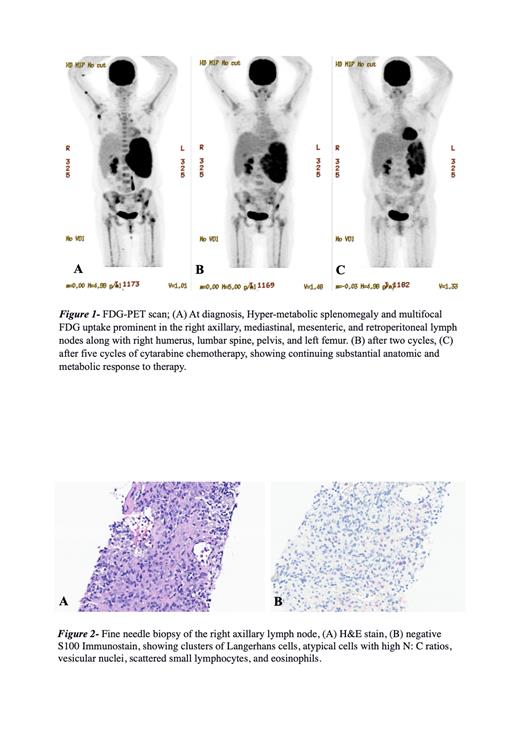Introduction:
Langerhans Cell Histiocytosis (LCH) is a rare neoplastic disorder of myeloid dendritic cell precursors, leading to a spectrum of organ involvement and dysfunction. The nonspecific presentations result in missed or delayed diagnoses in adults, and data to guide the clinical care of adults with LCH is limited to case studies and series.
Case Description:
A 40-year-old Hispanic woman presented to the Emergency Department with ongoing symptoms of shortness of breath, muscle cramps, and intermittent chest pain for two weeks. She was found to have microcytic-hypochromic anemia requiring packed Red Blood Cells (pRBC) transfusion. A CT pulmonary angiogram showed incidental findings of splenomegaly and right axillary lymphadenopathy.
A month before this presentation, she was evaluated for symptoms of polyuria, polydipsia, nocturia, and amenorrhea, ongoing for eight months. Arginine Vasopressin Deficiency (AVP-D) was diagnosed, and desmopressin was initiated. MRI Brain had revealed enhancement of the infundibular stalk.
On follow-up in the clinic, an ultrasound of the right axilla showed a 2.4 cm lymph node (LN) with thickened cortex. Over the following month, she continued to require multiple pRBC transfusions. Further workup with Fluorodeoxyglucose (FDG)-Positron Emission Tomography (PET) revealed hypermetabolic splenomegaly with multifocal uptake, including the right axilla suspicious for metastatic disease. ( Figure 1-A)
A biopsy of the right axillary LN ( Figure 2 - A, B) showed clusters of Langerhans cells and immunohistochemistry positive for CD1a, CD3, CD20, CD68, keratin, and CD 207 (Langerin) staining and variable positivity for S100. Next-Generation Sequencing showed BRAF V600E missense mutation and NOTCH3, DICER1, CREBBP, JAK1, and CTNNA1 as Variants of Unknown Significance (VUS). Bone marrow (BM) aspirate and flow cytometry were unremarkable. A diagnosis of Multi-System LCH with Risk Organ Involvement (MS-RO +) was made.
Cytarabine therapy was started at 150 mg/m 2(days 1-5, 28-day cycle). She was hospitalized twice due to sepsis, leukocytosis, severe anemia: Hemoglobin (Hb) 3.1, and grade 4 thrombocytopenia. Cycle 2 was delayed, and the dose was reduced to 50%. Post-infusions, Hb decline necessitated multiple pRBC transfusions. Repeat FDG-PET after cycles 2 and 5 ( Figure 1-B, C) showed continued metabolic and anatomic response to therapy. A repeat brain MRI showed no change in pituitary findings. The patient continues to improve clinically with plans to complete a total of one year of chemotherapy.
Discussion:
LCH is defined by the presence of CD1a +/CD207 + histiocytes. Although usually positive for S-100, rare S-100 negative variants have been reported in skin-limited LCH and LC-Sarcoma. An aberrant maturation process was proposed as a possible explanation, but the exact pathology remains unknown.
In children <15 years, the incidence is 2.6-8.9 cases/million/year; in adults, the incidence is less defined at 0.07 cases/million/year and is higher in Hispanics. Adult LCH typically presents after the fourth decade; two-thirds have multi-system involvement. Hematopoietic dysfunction, cytopenias, and liver involvement carry a poor prognosis. AVP-D is the most frequently associated endocrine abnormality.
Whole-exome sequencing has shown very low somatic mutation frequency in LCH compared to other neoplastic disorders. BRAF, a central kinase in the RAS-RAF-MEK pathway, has a missense V600E mutation in roughly 50% of LCH, rendering it constitutionally active. Other mutations include BRAF, MAP2K1, ARAF, ERBB3, NRAS, and KRAS, but the VUS mentioned above have been reported infrequently.
The LCH-III trial confirmed Vinblastine/Prednisone as the standard regimen for MS-LCH patients <18 years, with or without RO involvement. While it is effective in adults, its limited tolerance favors the use of cytarabine or cladribine. NCT02670707 is an ongoing trial comparing cytarabine monotherapy versus Vinblastine/Prednisone for frontline treatment. BRAF inhibitors are also being increasingly investigated. Prospective trials to optimize the duration of therapy (LCH-IV) and potential combination therapies are currently underway.
Disclosures
No relevant conflicts of interest to declare.


